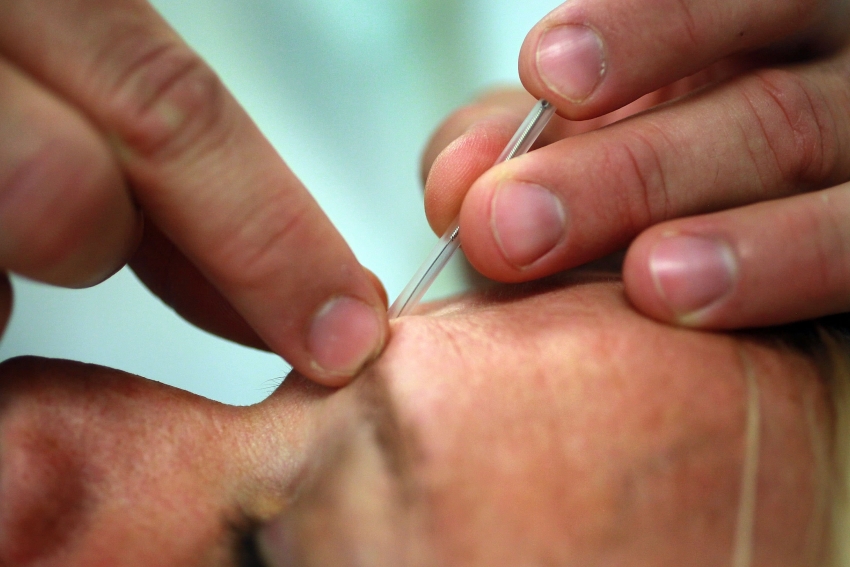Bright Room Community Acupuncture is a community clinic in Hackney. We treat a variety of conditions with acupuncture, such as pain, sports injuries, headaches, menstural issues, digestive problems, stress and more. Read on to find out more about the history, theory and uses of acupuncture.
Contact us to find out if we can help you.

Acupuncuture is a powerful healing modality with a long history of study and use.
Acupuncture has a rich history and cultural context in Asia, particularly in China. Its origins can be traced back over 2,500 years to ancient Chinese medical texts such as the Huangdi Neijing (Yellow Emperor’s Inner Canon). These texts form the foundation of traditional Chinese medicine (TCM), which emphasizes balance and harmony within the body. Acupuncture is an integral part of TCM, focusing on the body’s energetic pathways known as meridians. Over time, acupuncture techniques and theories have evolved, incorporating new knowledge and understanding of the human body.
This evolution has given rise to different styles and systems of acupuncture, including Japanese and Korean acupuncture, each with its own unique approaches.
Acupuncture can treat a wide variety of conditions
Acupuncture developed from the study of massage therapy – therapists began to utilise different tools, in addition to their hands. These tools eventually evolved to the acupuncture needles we use today. Can therefore provide amazing results with muscular skeletal issues and pain – but it can treat so much more. Some of the areas we see great results in are:
Pain Management: Acupuncture is widely recognized for its effectiveness in alleviating chronic pain conditions. By stimulating specific points on the body, acupuncture triggers the release of endorphins, the body’s natural painkillers. It has shown promising results in conditions such as back pain, migraines, osteoarthritis, fibromyalgia, and even postoperative pain. Additionally, acupuncture reduces inflammation, improves blood circulation, and promotes the body’s natural healing mechanisms.
Stress Reduction and Emotional Well-being: Acupuncture has a profound impact on the body’s energy flow, known as Qi. By targeting specific points along the body’s meridians, acupuncture helps restore balance and harmony, leading to reduced stress, anxiety, and improved mental well-being. It can also assist in addressing symptoms of depression, insomnia, and post-traumatic stress disorder (PTSD).
Digestive Health: Acupuncture has been used for centuries to address various digestive disorders. By regulating digestive function, reducing inflammation in the gastrointestinal tract, and promoting optimal organ function, acupuncture can provide relief from conditions such as irritable bowel syndrome (IBS), acid reflux, constipation, and even nausea associated with chemotherapy.
Women’s Health and Fertility: Acupuncture has shown promising results in supporting women’s health and fertility. It can be used in conjunction with fertility treatments to enhance their effectiveness. Acupuncture helps regulate menstrual cycles, promote optimal hormone balance, address conditions such as polycystic ovary syndrome (PCOS) and endometriosis, and provide emotional support during the journey to conception.
Respiratory Health: Acupuncture offers relief for allergies, asthma, and sinusitis. By reducing inflammation, improving immune response, and restoring respiratory function, it can alleviate symptoms and promote better respiratory health.
Cancer Supportive Care: Acupuncture is increasingly being utilized as a supportive therapy for cancer patients. It helps manage treatment side effects such as nausea, fatigue, pain, and anxiety. Acupuncture can improve quality of life during cancer treatment and aid in the recovery process.
Studies on the effectiveness of acupuncture:
Over the years, more and more studies are being published that show that acupuncture is an effective treatment choice:
Pain Management: Acupuncture is widely acknowledged for its effectiveness in alleviating chronic pain. A meta-analysis published in JAMA Internal Medicine examined 29 high-quality randomized controlled trials (RCTs) and found that acupuncture provided significantly better pain relief compared to sham acupuncture and standard care for conditions such as chronic back pain, osteoarthritis, and migraines.
Mental Health: Acupuncture has shown promise as a complementary therapy for mental health conditions. A randomized controlled trial published in the Journal of Clinical Psychiatry compared acupuncture to an antidepressant medication in the treatment of depression. The study revealed that acupuncture was equally effective in reducing depressive symptoms as the medication, highlighting its potential as an alternative or adjunctive treatment for depression.
Women’s Health and Fertility: Several studies have explored the benefits of acupuncture in women’s health and fertility. In a meta-analysis published in the Journal of Obstetrics and Gynecology Canada, acupuncture was found to improve pregnancy rates in women undergoing in vitro fertilization (IVF) treatments. The analysis indicated that acupuncture administered around the time of embryo transfer significantly increased the likelihood of successful pregnancy.
Cancer Supportive Care: Acupuncture has been utilized as a supportive therapy for cancer patients, helping manage treatment side effects and improve overall well-being. A systematic review published in the Journal of Clinical Oncology examined 17 RCTs and concluded that acupuncture effectively reduced chemotherapy-induced nausea and vomiting. Additionally, acupuncture was found to alleviate cancer-related pain and improve quality of life for patients undergoing cancer treatments.
Allergies and Respiratory Disorders: Acupuncture has demonstrated positive results in the treatment of allergies, asthma, and other respiratory disorders. A study published in the Annals of Internal Medicine compared acupuncture to sham acupuncture and antihistamine medication for the treatment of allergic rhinitis. The findings revealed that acupuncture provided significant symptom relief and improved quality of life, surpassing the outcomes of the sham acupuncture and antihistamine groups.
Digestive Disorders: Several studies have investigated the efficacy of acupuncture in addressing digestive disorders such as irritable bowel syndrome (IBS) and acid reflux. A systematic review published in the World Journal of Gastroenterology analyzed 12 RCTs and concluded that acupuncture was effective in reducing IBS symptoms and improving quality of life for patients. Furthermore, acupuncture has been shown to regulate digestive function, reduce inflammation, and alleviate symptoms associated with acid reflux and other gastrointestinal conditions.
Musculoskeletal Conditions: Acupuncture has demonstrated positive outcomes in the treatment of musculoskeletal conditions, including osteoarthritis and fibromyalgia. A study published in the Journal of Pain examined 570 patients with osteoarthritis of the knee and found that acupuncture provided significant pain relief and improved physical function compared to sham acupuncture and standard care. Similarly, a randomized controlled trial published in the Journal of Alternative and Complementary Medicine indicated that acupuncture reduced pain and improved quality of life for fibromyalgia patients.

How does acupuncture work?
According to traditional Chinese medicine, the human body is believed to be governed by a vital energy force called Qi (pronounced “chee”). Qi flows through specific pathways in the body known as meridians, which are interconnected with organs and tissues. The balance and harmonious flow of Qi are considered vital for optimal health. When there is an imbalance or blockage in Qi flow, it can lead to physical or emotional ailments.
Acupuncture restores the balance of Qi by stimulating specific points along the meridians. These points, known as acupoints, are areas where Qi can be accessed and influenced. By inserting thin needles into these acupoints, acupuncturists aim to restore the proper flow of Qi and promote the body’s self-healing mechanisms. The stimulation of acupoints is regulates the energy flow, harmonize organ function, and promote overall well-being.
From a Western perspective, the mechanisms of acupuncture are explained through physiological and neurobiological theories. Extensive research has revealed several theories that provide insight into how acupuncture works from a Western medical standpoint:
Neurotransmitter and Hormonal Regulation: Acupuncture has been shown to stimulate the release of various neurotransmitters and hormones. Studies indicate that acupuncture can increase the release of endorphins, which are natural pain-relieving substances. Additionally, acupuncture has been found to modulate the release of serotonin, norepinephrine, and dopamine, which play crucial roles in mood regulation and pain perception.
Neural Pathway Activation: Acupuncture involves the stimulation of specific acupoints, which triggers the activation of nerve fibers. This stimulation sends signals to the brain, activating various regions involved in pain perception, mood regulation, and immune response. Additionally, acupuncture has been found to stimulate the release of adenosine, a molecule known to have pain-relieving and anti-inflammatory effects.
Modulation of Inflammation and Immune Response: Acupuncture has demonstrated the ability to modulate the body’s inflammatory and immune responses. It can reduce the production of pro-inflammatory cytokines and promote the release of anti-inflammatory substances. This modulation of inflammation and immune response contributes to the therapeutic effects of acupuncture in conditions such as chronic pain, allergies, and autoimmune disorders.
Connective Tissue Stimulation: Recent research suggests that acupuncture stimulates connective tissue, which plays a vital role in transmitting mechanical signals throughout the body. Acupuncture may influence the extracellular matrix and help restore tissue homeostasis by promoting cellular communication and tissue repair.
Acupuncture in Europe:
The Western world’s encounter with acupuncture began in the 17th and 18th centuries, as explorers, missionaries, and travelers returned from their expeditions to China, bringing with them tales of Chinese medical practices. These encounters sparked curiosity and a growing interest in the healing potential of acupuncture among Western intellectuals and medical professionals.
During the early 19th century, medical missionaries played a crucial role in introducing acupuncture to Europe. Among them was William Heberden, an English physician who published “Commentaries on the History and Cure of Diseases” in 1801. In this book, Heberden included descriptions of acupuncture and its therapeutic applications, arousing the curiosity of Western medical practitioners.
Later, in the 20th Century, George Soulie de Morant, a French diplomat and sinologist, made significant contributions to the dissemination of acupuncture knowledge in Europe. Soulie de Morant devoted himself to studying Chinese medicine extensively and translated key texts on acupuncture and traditional Chinese medicine into French. His translations, particularly “L’Acuponcture Chinoise,” helped popularize acupuncture and made it more accessible to European medical practitioners and the general public.
In the UK, one of the most influential people was J.R. Worsley, who helped introduce acupuncture to the country. He studied acupuncture in the 1950s and 1960s in China, learning from renowned acupuncturists. Worsley returned to the UK and introduced the Five-Element Acupuncture system, which focused on the balance of the five elements within the body and the restoration of overall well-being.
Worsley’s teachings and training programs attracted a dedicated following of students who embraced his approach to acupuncture. The College of Traditional Acupuncture (CTA) in Leamington Spa, founded by Worsley in 1972, became a prominent institution for training acupuncturists in the UK. Worsley’s influence helped shape the practice and understanding of acupuncture in the country.
